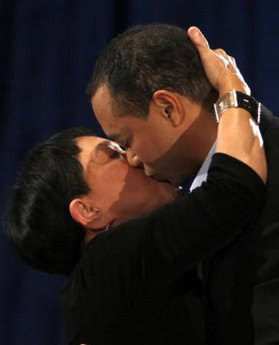...two years after he won the U.S. Open for the first time at Cherry Hills, Palmer found himself in an 18-hole playoff with a young, pudgy professional from Columbus, Ohio, named Jack Nicklaus, a former two-time U.S. Amateur champion whom Palmer had met several years earlier in an exhibition match in Athens, Ohio. The pro-Palmer crowd -- Arnie's Army -- was out in full force for the playoff, just as it had been throughout the 72 holes of regulation when the two players finished tied at 1-under 283. This time, though, there was only one player standing in the way of their hero, and Nicklaus was the target.
They called him names -- "Fat Jack," among them -- and chided him to "miss it." A sign, held by a man under a tree, said "Hit it Here Jack." Nicklaus, though, was oblivious.
"I had no idea what the gallery was doing," Nicklaus said.
"A 22-year-old kid wouldn't even have a clue. I didn't know the gallery was cheering for Arnold and all that stuff. It's hard for people to believe that, but it's true.
"When you're that age and you got something on your mind you want to do, you don't pay much attention to what's going on on the outside."
Maybe for Nicklaus. But not for his few supporters who were walking among the Palmer faithful in the gallery.
One of them was Woody Hayes, the former Ohio State football coach.
Hayes and Nicklaus' father, Charlie, were friends because Hayes always shopped in his drug store, which was located a few blocks from the Ohio State campus. Hayes was in the gallery following the young Golden Bear in the 1960 U.S. Open in Denver and the 1961 Open at Oakland Hills in suburban Detroit.
And he was there that day at Oakmont when the pro-Palmer sentiment became too much for him.
"Woody was Woody," Nicklaus recalled a couple weeks ago, smiling at the memory. "They said the two of them had to hold off the Oakmont crowd by themselves.
"Woody would get very upset with people in the gallery. People would say something, Woody wasn't going to exactly back off. It wasn't an issue at the other places."
It was at Oakmont, and it was because Nicklaus beat Palmer in the playoff, 71 to 74, to win his first professional title and the first of his 18 major championships. It was more than the beginning of the Nicklaus era. The victory signaled the changing of the guard, the moment the blond-haired kid from Ohio State replaced Palmer as the dominating figure in golf.
"Jack became Jack," Palmer said. "That triggered it."
After the playoff, Palmer told some members of the media, "Now that the big guy is out of the cage, everybody better run for cover."
He was talking about Jack Nicklaus.
Not Woody Hayes.
Link:
U.S. Open: Battle of '62 had Jack, Arnie, Woody
I guess that takes a new meaning now huh?) would have been ejected immediately if it was Nicklaus putting 30 years ago. Just remember that.





